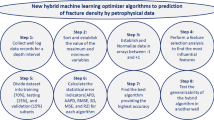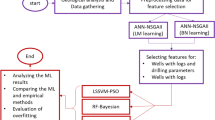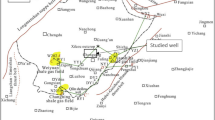Abstract
Accurate prediction of pore-pressures in the subsurface is paramount for successful planning and drilling of oil and gas wellbores. It saves cost and time and helps to avoid drilling problems. As it is expensive and time-consuming to measure pore-pressure directly in wellbores, it is useful to be able to predict it from various petrophysical input variables on a supervised learning basis calibrated to a benchmark wellbore. This study developed and compared three-hybrid machine-learning optimization models applied to a diverse suite of 9 petrophysical input variables to predict pore-pressure across a 273-m-thick, predominately carbonate, reservoir sequence in the giant Marun oil field (Iran) using 1972 data records. The analysis identified that the multilayer extreme learning machine model hybridized with a particle swarm optimization (MELM–PSO) applied to seven input variables by feature selection provided the most accurate pore-pressure predictions for the full dataset (RMSE = 11.551 psi (1 psi = 6.8947590868 kPa) for well MN#281). The Savitzky–Golay (SG) filter was applied to pre-process the data, and the properties were filter-ranked using the wrapping method. The MELM–PSO model outperformed the pore-pressure prediction accuracy achieved by commonly used empirical formulas involving sonic or resistivity log data or calculated pore compressibility. To further verify and generalize the applicability of the MELM–PSO model, it was applied to two other Marun oil field wells (MN#297 and MN#378) achieving RMSE prediction accuracy of 10.031 psi and 10.150 psi, respectively. These results confirmed that the trained model can be reliably applied to multiple locations across the Marun oil field for predicting pore-pressure.



















Similar content being viewed by others
Notes
1 inch = 0.0254 m.
1 cubic feet = 0.0283168466 cubic meter.
1 psi = 6.8947590868 kPa.
1 psi = 6.8947590868 kPa.
1 psi = 6.8947590868 kPa.
References
Adankon, M. M., & Cheriet, M. (2009). Model selection for the LS-SVM. Application to handwriting recognition. Pattern Recognition, 42(12), 3264–3270.
Ahmed, A., Elkatatny, S., Ali, A., Mahmoud, M., & Abdulraheem, A. (2019). New model for pore pressure prediction while drilling using artificial neural networks. Arabian Journal for Science and Engineering, 44(6), 6079–6088.
Ahmed, S., Mahmoud, A. A., Elkatatny, S., Mahmoud, M., & Abdulraheem, A. (2019). Prediction of pore and fracture pressures using support vector machine. Paper presented at the international petroleum technology conference. https://doi.org/10.2523/IPTC-19523-MS
Ali, J. (1994). Neural networks: a new tool for the petroleum industry? Paper presented at the European petroleum computer conference. https://doi.org/10.2118/27561-MS
Anemangely, M., Ramezanzadeh, A., & Tokhmechi, B. (2017). Shear wave travel time estimation from petrophysical logs using ANFIS-PSO algorithm: A case study from Ab-Teymour Oilfield. Journal of Natural Gas Science and Engineering, 38, 373–387.
Andrian, D., Rosid, M. S., & Septyandy, M. R. (2020). Pore pressure prediction using anfis method on well and seismic data field “Ayah”. In IOP Conference Series: Materials Science and Engineering (Vol. 854, No. 1, p. 012041). IOP Publishing. https://doi.org/10.1088/1757-899X/546/3/032017/meta
Atashbari, V., & Tingay, M. R. (2012). Pore pressure prediction in carbonate reservoirs. Paper presented at the SPE Latin America and Caribbean petroleum engineering conference. https://doi.org/10.2118/150835-MS
Atashnezhad, A., Wood, D. A., Fereidounpour, A., & Khosravanian, R. (2014). Designing and optimizing deviated wellbore trajectories using novel particle swarm algorithms. Journal of Natural Gas Science and Engineering, 21, 1184–1204.
Azadpour, M., Manaman, N. S., Kadkhodaie-Ilkhchi, A., & Sedghipour, M.-R. (2015). Pore pressure prediction and modeling using well-logging data in one of the gas fields in south of Iran. Journal of Petroleum Science and Engineering, 128, 15–23.
Bishop, C. M. (2006). Pattern recognition and machine learning. Springer.
Bowers, G. L. (1995). Pore pressure estimation from velocity data: Accounting for overpressure mechanisms besides undercompaction. SPE Drilling and Completion, 10(02), 89–95.
Chandrashekar, G., & Sahin, F. (2014). A survey on feature selection methods. Computers & Electrical Engineering, 40(1), 16–28.
Choubineh, A., Ghorbani, H., Wood, D. A., Moosavi, S. R., Khalafi, E., & Sadatshojaei, E. (2017). Improved predictions of wellhead choke liquid critical-flow rates: Modelling based on hybrid neural network training learning based optimization. Fuel, 207, 547–560.
Darling, T. (2005). Well-logging and formation evaluation. Elsevier.
Eaton, B. A. (1975). The equation for geopressure prediction from well-logs. Paper presented at the fall meeting of the Society of Petroleum Engineers of AIME. https://doi.org/10.2118/5544-MS
Farsi, M., Barjouei, H. S., Wood, D. A., Ghorbani, H., Mohamadian, N., Davoodi, S., Nasriani, H. R., & Ahmadi Alvar, M. (2021). Prediction of oil flow rate through orifice flow meters: Optimized machine-learning techniques. Measurement. https://doi.org/10.1016/j.measurement.2020.108943
Ghasemi, M., & Bayuk, I. (2020). Bounds for pore space parameters of petroelastic models of carbonate rocks. IZVESTIYA, Physics of the Solid Earth. https://doi.org/10.1134/S1069351320020032
Ghorbani, H., Moghadasi, J., & Wood, D. A. (2017a). Prediction of gas flow rates from gas condensate reservoirs through wellhead chokes using a firefly optimization algorithm. Journal of Natural Gas Science and Engineering, 45, 256–271.
Ghorbani, H., & Moghadasi, J. (2014). Development of a new comprehensive model for choke performance correlation in Iranian oil wells. Advances in Environmental Biology, 8(17), 877–882.
Ghorbani, H., Moghadasi, J., Dashtbozorg, A., & Abarghoyi, P. G. (2017b). The exposure of new estimating models for bubble point pressure in crude oil of one of the oil fields in Iran. American Journal of Oil and Chemical Technologies, 178–193.
Ghorbani, H., Wood, D. A., Choubineh, A., Mohamadian, N., Tatar, A., Farhangian, H., & Nikooey, A. (2020a). Performance comparison of bubble point pressure from oil PVT data: Several neurocomputing techniques compared. Experimental and Computational Multiphase Flow, 2(4), 225–246.
Ghorbani, H., Moghadasi, J., Dashtbozorg, A., & Kooti, S. (2017c). Developing a new multiphase model for choke function relation for Iran's gas wells. American Journal of Oil and Chemical Technologies.
Ghorbani, H., Wood, D. A., Choubineh, A., Tatar, A., Abarghoyi, P. G., Madani, M., & Mohamadian, N. (2018). Prediction of oil flow rate through an orifice flow meter: Artificial intelligence alternatives compared. Petroleum. https://doi.org/10.1016/j.petlm.2018.09.003
Ghorbani, H., Wood, D. A., Moghadasi, J., Choubineh, A., Abdizadeh, P., & Mohamadian, N. (2019). Predicting liquid flow-rate performance through wellhead chokes with genetic and solver optimizers: An oil field case study. Journal of Petroleum Exploration and Production Technology, 9(2), 1355–1373.
Ghorbani, H., Moghadasi, J., Mohamadian, N., Mansouri Zadeh, M., Hezarvand Zangeneh, M., Molayi, O., & Kamali, A. (2014). Development of a New Comprehensive Model for Choke Performance Correlation in Iranian Gas Condensate Wells, 8(17), 308–313.
Ghorbani, H., Wood, D. A., Mohamadian, N., Rashidi, S., Davoodi, S., Soleimanian, A., & Mehrad, M. (2020b). Adaptive neuro-fuzzy algorithm applied to predict and control multi-phase flow rates through wellhead chokes. Flow Measurement and Instrumentation, 76, 101849.
Huang, G.-B., Zhu, Q.-Y., & Siew, C.-K. (2006). Extreme learning machine: Theory and applications. Neurocomputing, 70(1–3), 489–501.
Hutomo, P. S., Rosid, M. S., & Haidar, M. W. (2019). Pore pressure prediction using eaton and neural network method in carbonate field “X” based on seismic data. In IOP conference series: Materials science and engineering (Vol. 546, No. 3, p. 032017). IOP Publishing. https://doi.org/10.1088/1757-899X/546/3/032017/meta
Jain, A., & Zongker, D. (1997). Feature selection: Evaluation, application, and small sample performance. IEEE Transactions on Pattern Analysis and Machine Intelligence, 19(2), 153–158.
John, G. H., Kohavi, R., & Pfleger, K. (1994). Irrelevant features and the subset selection problem. In Machine learning proceedings 1994 (pp. 121–129). Morgan Kaufmann. https://doi.org/10.1016/B978-1-55860-335-6.50023-4
Kennedy, J. (1997). The particle swarm: social adaptation of knowledge. Paper presented at the proceedings of 1997 IEEE international conference on evolutionary computation (ICEC'97). https://doi.org/10.1080/10.1109/ICEC.1997.592326.
Kennedy, J., & Eberhart, R. (1995). Particle swarm optimization. Paper presented at the proceedings of ICNN'95-international conference on neural networks. https://doi.org/10.1080/10.1109/ICNN.1995.488968.
Keshavarzi, R., & Jahanbakhshi, R. (2013). Real-time prediction of pore pressure gradient through an artificial intelligence approach: A case study from one of Middle East oil fields. European Journal of Environmental and Civil Engineering, 17(8), 675–686.
Kisi, O., & Parmar, K. S. (2016). Application of least square support vector machine and multivariate adaptive regression spline models in long term prediction of river water pollution. Journal of Hydrology, 534, 104–112.
Kohavi, R., & John, G. H. (1997). Wrappers for feature subset selection. Artificial Intelligence, 97(1–2), 273–324.
Lima, C. A., Coelho, A. L., & Eisencraft, M. (2010). Tackling EEG signal classification with least squares support vector machines: A sensitivity analysis study. Computers in Biology and Medicine, 40(8), 705–714.
Liu, H. (2017). Principles and applications of well-logging. Springer. https://doi.org/10.1007/978-3-662-53383-3
Liu, J., Liu, X., Liu, C., Le, B. T., & Xiao, D. (2019). Random search enhancement of incremental regularized multiple hidden layers ELM. IEEE Access, 7, 36866–36878.
Liu, J., Liu, X., & Le, B. T. (2019b). Rolling force prediction of hot rolling based on GA-MELM. Complexity, 2019. https://www.hindawi.com/journals/complexity/2019/3476521/
Lyons, W. C., & Plisga, G. J. (2011). Standard handbook of petroleum and natural gas engineering. Elsevier.
Maimon, O., & Rokach, L. (2009). Introduction to knowledge discovery and data mining. In Data mining and knowledge discovery handbook (pp. 1–15): Springer. https://doi.org/10.1007/978-0-387-09823-4_1.
Mohammadian, N., & Ghorbani, H. (2015). An investigation on chemical formation damage in Iranian reservoir by focus on mineralogy role in shale swelling potential in Pabdeh and Gurpi formations. Advances in Environmental Biology, 9(4), 161–166.
Mohamadian, N., Ghorbani, H., Wood, D. A., & Hormozi, H. K. (2018). Rheological and filtration characteristics of drilling fluids enhanced by nanoparticles with selected additives: An experimental study. Advances in Geo-Energy Research, 2(3), 228–236.
Mohamadian, N., Ghorbani, H., Wood, D. A., & Khoshmardan, M. A. (2019). A hybrid nanocomposite of poly (styrene-methyl methacrylate-acrylic acid)/clay as a novel rheology-improvement additive for drilling fluids. Journal of Polymer Research, 26(2), 33.
Mohamadian, N., Ghorbani, H., Wood, D. A., Mehrad, M., Davoodi, S., Rashidi, S., & Shahvand, A. K. (2021). A geomechanical approach to casing collapse prediction in oil and gas wells aided by machine learning. Journal of Petroleum Science and Engineering, 196, 107811.
Mustafa, M., Rezaur, R., Rahardjo, H., & Isa, M. (2012). Prediction of pore-water pressure using radial basis function neural network. Engineering Geology, 135, 40–47.
Osborne, M. J., & Swarbrick, R. E. (1997). Mechanisms for generating overpressure in sedimentary basins: A reevaluation. AAPG Bulletin, 81(6), 1023–1041.
Polito, C. P., Green, R. A., & Lee, J. (2008). Pore pressure generation models for sands and silty soils subjected to cyclic loading. Journal of Geotechnical and Geoenvironmental Engineering, 134(10), 1490–1500.
Ranaee, E., Ghorbani, H., Keshavarzian, S., Ghazaeipour Abarghoei, P., Riva, M., Inzoli, F., & Guadagnini, A. (2021). Analysis of the performance of a crude-oil desalting system based on historical data. Fuel. https://doi.org/10.1016/j.fuel.2020.120046
Rashidi, S., Mohamadian, N., Ghorbani, H., Wood, D. A., Shahbazi, K., & Ahmadi Alvar, M. (2020). Shear modulus prediction of embedded pressurize salt layers and pinpointing zones at risk of casing collapse in oil and gas wells. Journal of Applied Geophysics, 104205.
Rashidi, S., Mehrad, M., Ghorbani, H., Wood, D. A., Mohamadian, N., Moghadasi, J., & Davoodi, S. (2021). Determination of bubble point pressure and oil formation volume factor of crude oils applying multiple hidden layers extreme learning machine algorithms. Journal of Petroleum Science and Engineering. https://doi.org/10.1016/j.petrol.2021.108425
Rehm, B., Schubert, J., Haghshenas, A., Paknejad, A. S., & Hughes, J. (2013). Managed pressure drilling. Elsevier.
Rubin, Y., & Hubbard, S. (2005). Hydrogeophysics, water science and technology library. Springer.
Satter, A., & Iqbal, G. M. (2015). Reservoir engineering: The fundamentals, simulation, and management of conventional and unconventional recoveries. Gulf Professional Publishing.
Shi, Y., & Wang, C. Y. (1986). Pore pressure generation in sedimentary basins: Overloading versus aquathermal. Journal of Geophysical Research: Solid Earth, 91(B2), 2153–2162.
Simon, D. (2013). Evolutionary optimization algorithms. Wiley.
Suykens, J. A., & Vandewalle, J. (1999). Least squares support vector machine classifiers. Neural Processing Letters, 9(3), 293–300.
Swarbrick, R. E. (2001). Challenges of porosity-based pore pressure prediction. Paper presented at the 63rd EAGE conference & exhibition. https://doi.org/10.3997/2214-4609-pdb.15.O-25.
Terzaghi, K., Peck, R. B., & Mesri, G. (1996). Soil mechanics in engineering practice (3rd edn.). John Wiley & Sons.
Vapnik, V. (2013). The nature of statistical learning theory. Springer.
Wahab, M. N. A., Nefti-Meziani, S., & Atyabi, A. (2015). A comprehensive review of swarm optimization algorithms. PLoS ONE, 10(5), 1–36.
Wang, S.-J., Chen, H.-L., Yan, W.-J., Chen, Y.-H., & Fu, X. (2014). Face recognition and micro-expression recognition based on discriminant tensor subspace analysis plus extreme learning machine. Neural Processing Letters, 39(1), 25–43.
Xiao, D., Li, B., & Mao, Y. (2017). A multiple hidden layers extreme learning machine method and its application. Mathematical Problems in Engineering, 2017. https://www.hindawi.com/journals/mpe/2017/4670187/
Yang, X.-S., & Papa, J. P. (2016). Bio-inspired computation and applications in image processing. Academic Press.
Yeom, C.-U., & Kwak, K.-C. (2017). Short-term electricity-load forecasting using a TSK-based extreme learning machine with knowledge representation. Energies, 10(10), 1613.
Yoshida, C., Ikeda, S., & Eaton, B. A. (1996). An investigative study of recent technologies used for prediction, detection, and evaluation of abnormal formation pressure and fracture pressure in North and South America. Paper presented at the SPE/IADC Asia Pacific Drilling Technology. https://doi.org/https://doi.org/10.2118/36381-MS.
Yu, H., Chen, G., & Gu, H. (2020). A machine learning methodology for multivariate pore-pressure prediction. Computers & Geosciences, 143, 104548.
Yuan, X., Chen, C., Yuan, Y., Huang, Y., & Tan, Q. (2015). Short-term wind power prediction based on LSSVM–GSA model. Energy Conversion and Management, 101, 393–401.
Acknowledgment
This research was supported by Tomsk Polytechnic University under Grant Number VIU-CPPSND-214/2020.
Author information
Authors and Affiliations
Corresponding author
Supplementary Information
Below is the link to the electronic supplementary material.
11053_2021_9852_MOESM1_ESM.xlsx
Supplementary file 1 An Excel file containing the ten variable values for the1792 data records evaluated in this study is available to download as a supplementary file. (XLSX 233 kb)
Rights and permissions
About this article
Cite this article
Farsi, M., Mohamadian, N., Ghorbani, H. et al. Predicting Formation Pore-Pressure from Well-Log Data with Hybrid Machine-Learning Optimization Algorithms. Nat Resour Res 30, 3455–3481 (2021). https://doi.org/10.1007/s11053-021-09852-2
Received:
Accepted:
Published:
Issue Date:
DOI: https://doi.org/10.1007/s11053-021-09852-2




